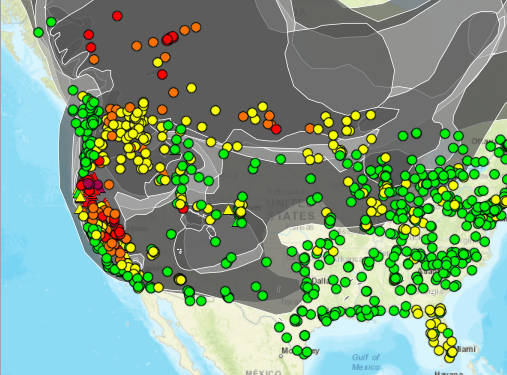
As the wildfires keep burning, air quality across the Western U.S., including the popular Yosemite National Park, has deteriorated to hazardous levels in some places.
Wildfires burning across California and the West are causing the smoke proliferation and resulting danger for at-risk individuals.
The Mendocino Complex Fires in California is the state's worst ever, and as of Wednesday, six new large fires were reported in the United States, bringing the active total to 107 that have burned 1.6 million acres across 14 states, reported the National Fire Information Center.
Wildfire smoke now reaches across half of the United States, according to the Environmental Protection Agency (EPA), and much of Canada, and levels in many areas are considered dangerous, with high levels of fine particulate pollution (PM 2.5). Areas with significant impact due to wildfires include California, Oregon and Nevada.
Air quality alerts have been issued in those states and others, reaching to Minnesota, for instance, where visibility in southern Manitoba decreased to four miles due to smoke on Wednesday, "indicating an increase in fine particle concentrations." In the populous San Francisco area the air quality suffers to the point that a "Spare the Air Day" was proclaimed, encouraging people to carpool and use public transit.
When concentrations reach hazardous levels the air can pose risks to children, older adults, people with respiratory problems and those working outside.
The Mendocino Complex Fire, claiming 292,000 acres as of August 8, has caused much of the smoke. The Ferguson Fire is the third largest in California, burning 95,000 acres, and its smoke is plaguing Yosemite National Park.
Smoke pollution has been so significant that Yosemite National Park closed on July 25 and remains indefinitely due to firefighting efforts and smoke in the area. Yosemite typically seems 15,000 to 20,000 visitors per day this time of year.
California wildfires are an annual occurrence, but this year's raging burns are not normal.
"In talking to people, no one has ever seen the smoke this heavy," said Scott Gediman, a Yosemite park spokesman, according to the Los Angeles Times.
"On three consecutive days, July 26 – 28, hourly levels of PM 2.5 pollution in Yosemite peaked above a suffocating 400 μg/m 3 , thanks to smoke from the Ferguson fire," reported Dr. Jeff Masters on wunderground.com. On August 3, a personal air pollution sensor made by purpleiar.org recorded even higher levels of PM2.5 at Wawona, on the south side of the park: an insanely high 1044 μg/m 3 ."
The EPA warns that such high levels can cause, "significant aggravation of heart or lung disease and premature mortality in persons with cardiopulmonary disease and the elderly; significant increase in respiratory effects in general population."
Uncommon Knowledge
Newsweek is committed to challenging conventional wisdom and finding connections in the search for common ground.
Newsweek is committed to challenging conventional wisdom and finding connections in the search for common ground.
About the writer
To read how Newsweek uses AI as a newsroom tool, Click here.








